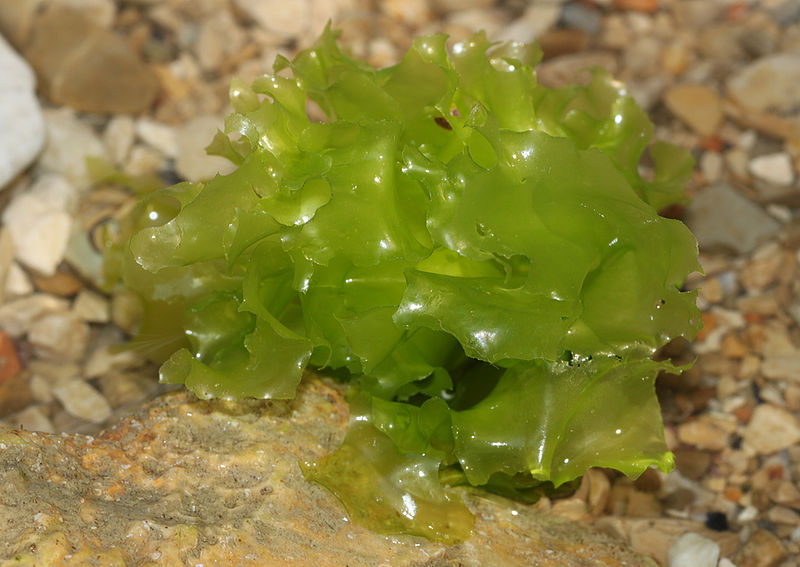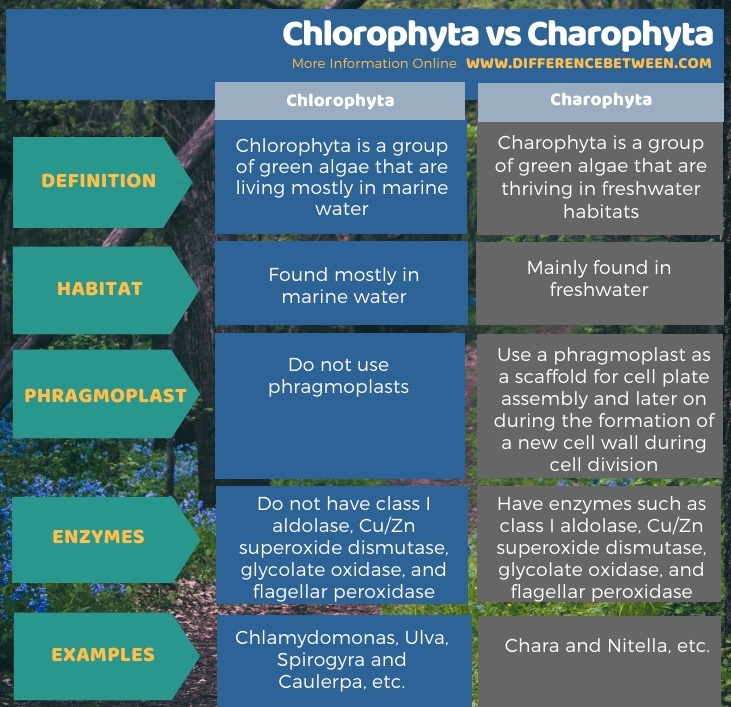The key difference between Chlorophyta and Charophyta is that Chlorophyta is a taxonomic group of green algae living predominantly in marine water while Charophyta is a taxonomic group of green algae thriving mainly in freshwater.
Green algae are one of the five groups of algae found mostly in freshwater and marine water. Few green algal species are present in terrestrial habitats, including soil, rocks, and trees. They can be unicellular or multi-cellular. Moreover, they are eukaryotic photosynthetic organisms that possess chloroplasts and photosynthetic pigments such as chlorophyll a and b, carotene and xanthophylls. Chlorophyta and Charophyta are two taxonomic groups of green algae.
CONTENTS
1. Overview and Key Difference
2. What is Chlorophyta
3. What is Charophyta
4. Similarities Between Chlorophyta and Charophyta
5. Side by Side Comparison – Chlorophyta vs Charophyta in Tabular Form
6. Summary
What is Chlorophyta?
Chlorophyta is a group of green algae that mainly comprise of marine species. Very few species are found in freshwater and terrestrial habitats. Some species of Chlorophyta also live in extreme habitats, such as deserts, hyper-saline environment, and arctic regions. They are greenish in colour. They have chloroplasts and chlorophyll pigments, particularly chlorophyll a and b. Furthermore, they have carotenoids. They store carbohydrates in the form of starch within plastids. Many Chlorophyta species are motile, and they have flagella on the apical portion.

Figure 01: Ulva
Chlorophytes reproduce via both sexual and asexual methods. Fission, fragmentation and production of zoospores are three modes of asexual reproduction shown by chlorophytes. Sexual reproduction can be isogamous, anisogamous, or oogamous. Chlamydomonas, Ulva, Spirogyra and Caulerpa are few species belonging to Chlorophyta.
What is Charophyta?
Charophyta is a group of green algae mostly living in freshwater habitats. They possess chloroplasts and chlorophyll pigments in order to carry out photosynthesis. Similar to Chlorophyta, Charophyta species store carbohydrates in the form of starch. Their cell walls are made up of cellulose.

Figure 02: Chara
However, charophytes are more closely related to embryophytes than Chlorophyta. Charophytes possess enzymes such as class I aldolase, Cu/Zn superoxide dismutase, glycolate oxidase, and flagellar peroxidase which are seen in embryophytes. Moreover, charophytes use phragmoplasts during cell division. Chara and Nitella are two types of charophytes.
What are the Similarities Between Chlorophyta and Charophyta?
- Chlorophyta and Charophyta are two groups of green algae.
- They are eukaryotic organisms.
- Moreover, they are photosynthetic organisms having chloroplasts and photosynthetic pigments, including chlorophyll a and chlorophyll b.
- Both store their carbohydrates as starch.
- They are an important source of organic material.
- Moreover, their cell wall is chiefly comprised of cellulose.
What is the Difference Between Chlorophyta and Charophyta?
Chlorophyta is a group of green algae that are living mostly in marine water while Charophyta is a group of green algae that are thriving in freshwater habitats. So, this is the key difference between Chlorophyta and Charophyta. Besides, another difference between Chlorophyta and Charophyta is their use of phragmoplasts. That is; chlorophytes do not use phragmoplasts, while charophytes use a phragmoplast as a scaffold for cell plate assembly and later on during the formation of a new cell wall during cell division. Moreover, chlorophytes do not have class I aldolase, Cu/Zn superoxide dismutase, glycolate oxidase, and flagellar peroxidase while charophytes have those enzymes.
Below infographic summarizes the difference between Chlorophyta and Charophyta.

Summary – Chlorophyta vs Charophyta
Chlorophyta and Charophyta are two phyla of green algae. Both phyla have species which are greenish in colour. Moreover, they are photosynthetic and eukaryotic. They store their carbohydrates as starch. Chlorophytes are mainly living in marine water while charophytes are living in freshwater habitats. So, this is the key difference between Chlorophyta and Charophyta. Also, another difference between Chlorophyta and Charophyta is that charophytes use phragmoplasts during cell division, while chlorophytes do not use phragmoplast. Moreover, charophytes have enzymes such as class I aldolase, Cu/Zn superoxide dismutase, glycolate oxidase, and flagellar peroxidase, while chlorophytes do not.
Reference:
1.“Chlorophyta.” Biology, 12 May 2014, Available here.
2. “Green Algae: Precursors of Land Plants.” Lumen, Available here.
Image Courtesy:
1. “Chara braunii 1” By Show_ryu – Own work (CC BY-SA 3.0) via Commons Wikimedia
2. “Meersalat-Ulva-lactuca” By H. Krisp – Own work (CC BY 3.0) via Commons Wikimedia
ncG1vNJzZmivp6x7pbXFn5yrnZ6YsqOx07CcnqZemLyue8OinZ%2Bdopq7pLGMm5ytr5Wau26vx6Wmq6egnca1rYyapZ1lk52us7vPobCtmV8%3D